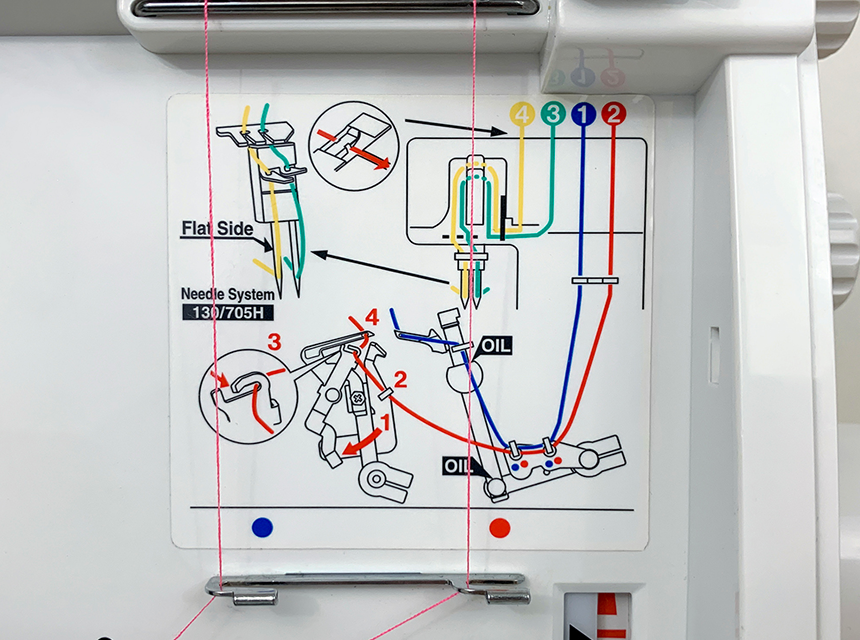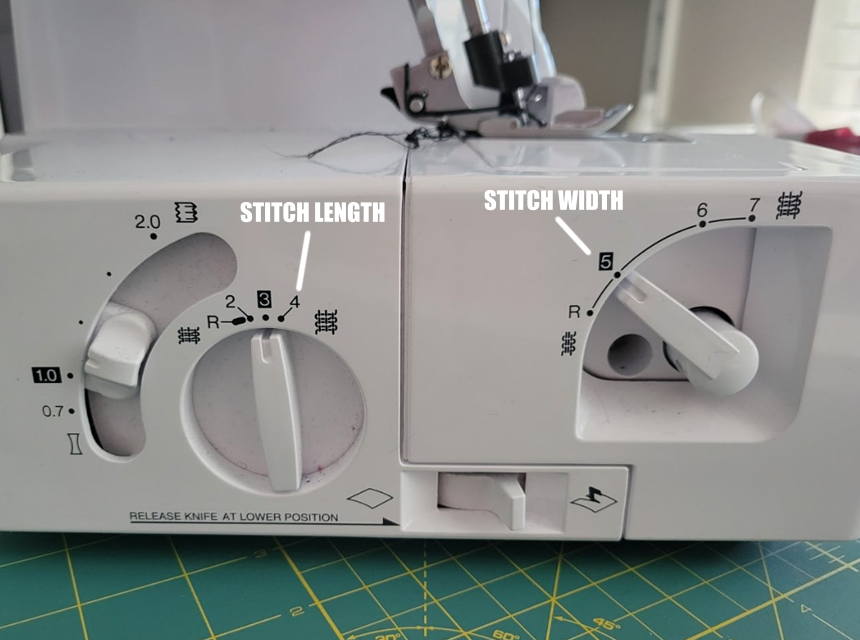

If the word overlocking makes you sick, then you are at the right place. Don’t worry, we all have been there with this frustrating and intricate task. However, it is not as hard as it seems once you get yourself one of the best sergers for beginners. This device can sew seams and create decorative edges, hems as well as ruffles, and gathered fabrics.
We reviewed 20 models to find the 6 best sergers for beginners, with Brother 1034D at the top. First, we looked at the number of threads. Most of our models offer 2/3/4 thread capability, making them very versatile. Next, we considered sewing speed, so you can complete projects quickly. The perfect speed for beginners is around 1,300 spm – a good balance between speed and control. We also considered ease of threading, so you can be sure that using these models will be a breeze.
And if you need something to make the perfect hem, check out our article on the 8 best sergers for making hems here!
More features: 2 needles, 2-4 mm stitch length, 7 mm stitch width, lay-in threading, stitch width control, F.A.S.T. lower looper
Brother 1034D is our Editor’s Choice because this serger has multiple features that make it easy to use and helps you create professional-looking seams even if you are a beginner. When sewing with this machine, you will be able to sew at speeds up to 1300 stitches per minute without compromising quality or durability. It also features 3/4 thread capacity, making it a great choice for all your sewing needs.
You might come across the Brother ST4031HD model when considering the Brother 1034D, as they are both designed to offer 1,300 stitches per minute, 3/4 thread capacity, and an included accessory fit. However, the ST4031HD is heavier and bulkier, for more advanced users. If you’re just starting out with a serger, the 1034D is a good place to start.
More features: 4 mm stitch length, safety switch, tension adjustment, cutting width adjustment, adjustable stitch length and width
This serger from JUKI sets itself apart from all of the other sergers we reviewed by offering an impressive needle speed of 1,500 stitches per minute. That makes it an ideal choice for sewers who are short on time or working on large projects where any bit of added sewing speed can make a big difference in total project time.
The serger has a 2-3-4-thread configuration to offer a wide variety of stitches and also has a feature to automatically stitch rolled hems to make quick work of that simple design. The stitch length is adjustable up to a maximum of four millimeters using a simple dial adjustment on the exterior of the serger. In addition, the cutting width and stitch width are both easy to adjust to get the perfect fabric edge.
The knife has its own drive system to increase its cutting power, making this serger a good choice for those who work with heavy fabrics often as well. However, users noted that the feed differential may need to be turned all the way up to create straight stitching patterns in heavy-duty fabrics.
Unfortunately, threading this serger can be an extreme challenge as there is no diagram on the machine itself and the instructions are typed in rather small font. Users suggest taking a lot of pictures of the machine, as it arrives pre-threaded and following photos is much easier than trying to follow the instruction manual.
Also note that in contrast to the usual 25-year warranty on serger machines, this model only comes with a five-year warranty.
More features: 8 built-in stitches, adjustable thread tension
Looking for a quality serger that’s easy to use? Then the Singer X5004-HD is just for you. With 8 built-in stitches and adjustable thread tension, it’s easy to get the perfect stitch every time. The heavy-duty metal frame ensures your machine lasts for years, while the quick and easy threading makes overlocking a breeze. Plus, with 1300 spm sewing speed, you’ll be able to finish your projects in no time at all.
Both the Singer X5004-HD and the Singer ProFinish 14CG754 are high-quality sergers providing professional results to beginners. They both feature 1300 stitches per minute and 2-3-4 thread capability. But, the X5004-HD has 8 built-in stitches which makes it ideal for beginners who don’t know much about using sergers. It also stands out with the larger cutting knife and the LED lights for working in dark areas.
More features: adjustable stitch width and length, adjustable presser foot pressure, accessory storage
For sewers who are interested in a serger primarily for working on heavy-duty fabrics, there are few options more suitable than this machine from Brother. First of all, the serger is constructed from a durable metal frame with primarily internal components to protect it from wear and tear. The adjustable presser foot is able to stand up to abuse from keeping heavy fabrics under pressure, and the unique add-on table stand serves to hold up fabrics so they don’t hang down and pull on the needle. It is worth noting that, like other heavy-duty and beginner sergers, this machine is limited to a maximum speed of 1,300 stitches per minute.
The serger also features a highly durable blade for cutting through dense fabrics without wearing down as quickly as competing blades. However, this blade is one of the larger detractions to this serger as once it breaks, you are forced to buy a replacement from Brother directly at up to three times the cost of most other serger blades.
The serger includes convenient controls for adjusting the stitch width and length, as well as a removable trim disposable bin so you can keep your work area clean as you go. Thread spools hang on a metal frame above the machine so they’re out of the way while threading the machine is relatively straightforward thanks to the arrow-based diagramming on the front panel. This is a great machine for future users of an industrial serger type.
Brother offers a long 25-year warranty on this serger to reflect its durable design.
More features: 97 stitch applications, adjustable tension and stitch length, 6 built-in stitches
Looking for a quality serger at an affordable price? Look no further than the Singer S0230. This machine features 1300 spm sewing speed, 2/3/4 thread options, and 25 years of warranty coverage. With 97 stitch applications and 6 built-in stitches, the Singer S0230 is perfect for any beginner sewer. Quick and easy threading makes set-up a breeze, while the color-coded thread guides keep you organized. The device provides a clean finish making it a great choice for any project.
The Singer S0230 is another 2/3/4 thread option on our list, like the Singer X5004-HD. But, what makes the S0230 stand out is the fact that the serger sews the seam and the seam finish simultaneously while trimming away excess allowance on the seam.
More features: differential feed; built-in rolled hem feature; extra-high presser foot lifter
The Janome 8002D Serger is an excellent choice for sewists who want a reliable, compact machine without sacrificing quality. At around 13 pounds, it’s lighter and smaller than many of its peers, making it easy to store or move between sewing spaces.
Despite its size, it give professional results with 3- and 4-thread overlock stitches, a built-in rolled hem feature, and differential feed for smooth seams on knits and woven fabrics alike. Beginners will appreciate the color-coded threading system, and more experienced users will value its consistent stitch quality.
While it doesn’t have the advanced features of higher-end sergers, the 8002D strikes the right balance between portability, ease of use, and performance—perfect for home sewing projects, or a beginner who wants to get to grips with the basics!
A serger is an excellent addition to any sewing kit, whether you are a beginner or an experienced sewer. It is a versatile machine that can do things that regular sewing machines cannot. If you are new to serging, read our guide to find the perfect model for you!
A serger is a type of sewing machine that is used to create professional-looking seams and edges on garments and other fabric projects. It can sew and finish seams in one step, which saves time and provides a neater appearance than would be possible with a regular sewing machine. The best sergers for beginners also have various functions for creating decorative edges, hems, and ruffles.

A serger uses a system of looping threads to create strong, finished seams much faster than it is possible with a regular sewing machine. It also trims away any excess fabric as it sews which helps to prevent fraying and creates a neater appearance. Sergers are an excellent choice for sewing stretchy or difficult-to-sew fabrics, as well as for projects that will be subject to a lot of wear and tear.
If you’re new to serging, the idea of using one may seem daunting. But don’t worry – with a little practice, you’ll be able to create professional-looking seams and finishes in no time!
First, you will need to thread the machine. Threading a serger can seem daunting at first, but luckily most machines come with a diagram that shows you exactly how to do it. Once the machine is threaded, you will need to adjust the tension of the threads.
Tension should be slightly higher for thinner fabrics and lower for thicker fabrics.
Next, you will need to choose the stitch you want to use. The most common serger stitches are the 3-thread stitch and the 4-thread stitch. Each of these stitches has a different purpose. The 3-thread stitch is best for general sewing, while the 4-thread stitch is more durable and better suited for heavy-duty projects.
After you have chosen your stitch, you are ready to start sewing! Be sure to test the stitch on a scrap piece of fabric before you start working on your project. This will help you to get a feel for the machine and avoid any mistakes.
A serger can be a sizable investment, so it’s important to choose one that will meet your needs. Some sergers are very basic and only have the essential functions, while others come with a wide range of built-in stitches and other features. Here are a few things to consider before making your purchase.
The number of the best serger threads that a device can use will determine the types of stitches that it is capable of creating. Most sergers come with either 2, 3, or 4 threads.
2-thread sergers are the most basic and are only capable of creating a straight stitch. These machines are typically very affordable, but they are not as versatile as other types of sergers.
3-thread sergers can create a variety of stitches, including the 3-thread stitch (which is the most common), the 4-thread stitch, and the safety stitch. These machines are more versatile than 2-thread sergers, but they may not be able to handle very thick or difficult-to-sew fabrics.
4-thread sergers are the most versatile type of serger, as they can create any type of stitch. These machines can handle any type of fabric, making them an excellent choice for sewers who plan to use a variety of fabrics.
Some sergers come with an automatic threading feature that makes it easier to thread the machine like the best self-threading sergers. This can be a very handy feature, especially if you are a beginner.
However, some experienced sewers prefer to thread their machines manually, as they feel that it gives them more control over the process.
Differential feed is a feature that allows you to adjust the speed at which the fabric is fed through the machine. This is an important feature to look for if you plan to sew stretchy or slippery fabrics, as it will help to prevent the fabric from bunching up or stretching out of shape.
The speed of the serger will determine how fast you can sew. It is measured in stitches per minute (SPM) and is about 1,000 – 2,000 for most machines.
If you plan to do a lot of sewing, you may want to choose a machine with a higher speed. However, if you are a beginner, you may want to start with a machine that has a lower speed so that you can get the hang of using it before sewing at a faster pace.

Stitch length and width play an important role in the overall look of your project.
Most sergers have adjustable stitch settings that allow you to customize the length and width to suit your needs and make your project look just the way you want it to.
All sergers come with a built-in cutting blade that trims the fabric as you sew. This is a very handy feature, as it eliminates the need to stop and trim the fabric manually after each seam.
However, not all cutting blades are created equal. Some sergers have a swing-away blade that can be moved out of the way when not in use, while others have a blade that is permanently attached to the machine.
The type of cutting blade you choose is a matter of personal preference, but swing-away blades are generally considered to be more convenient.
The type of foot that a serger has will determine what types of fabrics it can sew. Some sergers have a standard presser foot, while others have a walking foot or an even-feed foot.
Standard presser feet are designed for sewing most types of fabrics.
Walking feet are designed for sewing slippery or stretchy fabrics, as they help to prevent the fabric from bunching up.
Even-feed feet are designed for sewing difficult-to-sew fabrics, such as denim or canvas.
Sergers can range in price from $100 to $1,000. The price of the machine will depend on the features it offers and the brand.
If you are a beginner, you may want to start with a less expensive machine so that you can get the hang of using it before investing in a more expensive one.
However, if you plan to do a lot of sewing, you may want to invest in a more expensive machine that has more features and is more durable like the best industrial sergers.
Most sergers come with a warranty that covers the machine for a certain period of time. The length of the warranty will vary depending on the brand and model of the machine.
It is important to read the fine print of the warranty before you purchase a machine, as some warranties may only cover certain parts or repairs.
With proper care and maintenance, a serger can provide you with years of trouble-free sewing
It is important to clean your serger regularly to prevent lint and dust from building up on the machine. The best way to clean a serger is to use a soft, dry cloth to wipe down the machine after each use. If you notice any lint or dust build-up, you can use a canned air duster to clean the machine.
You should also oil your serger regularly to keep the moving parts lubricated. How often you need to oil the machine will depend on how often you use it. Check the manual for your specific machine to determine how often you should oil it.
There are a few things you should avoid doing when cleaning or oiling your serger.
Never use water or any other liquid to clean the machine.
Second, never oil the cutting blade, as this can cause the blade to become dull. Finally, never use any type of solvent to clean the machine, as this can damage the plastic parts.
Brother 1034D is very user-friendly, with features like lay-in threading and a convertible sewing surface. It also has a durable metal frame and can handle heavier fabrics like denim. Plus, it comes at an affordable price.
Juki MO-654DE is our second best serger for beginners, with adjustable stitch length and differential feed, as well as color-coded threading guides. It is quite fast so you’ll be able to create beautiful and smooth stitches in no time at all and get your projects done quickly.
The Singer X5004-HD features 8 built-in stitches and adjustable thread tension making it versatile and easy to use. Plus, the heavy-duty metal frame ensures lasting durability. In addition, with 1300 spm sewing speed, you’ll be done in no time!